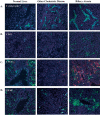Biliary atresia is associated with CD4+ Th1 cell-mediated portal tract inflammation
- PMID: 15128911
- PMCID: PMC1948976
- DOI: 10.1203/01.PDR.0000130480.51066.FB
Biliary atresia is associated with CD4+ Th1 cell-mediated portal tract inflammation
Abstract
A proposed mechanism in the pathogenesis of biliary atresia involves an initial virus-induced, progressive T cell-mediated inflammatory obliteration of bile ducts. The aim of this study was to characterize the inflammatory environment present within the liver of infants with biliary atresia to gain insight into the role of a primary immune-mediated process versus a nonspecific secondary response to biliary obstruction. Frozen liver tissue obtained from patients with biliary atresia, neonatal giant cell hepatitis, total parenteral nutrition (TPN)-related cholestasis, choledochal cysts, and normal control subjects was used for fluorescent immunohistochemistry studies of cellular infiltrates, cytokine mRNA expression, and in situ hybridization for localization of cytokine-producing cells. Immunohistochemistry revealed increases in CD8(+) and CD4(+) T cells and Kupffer cells (CD68(+)) in the portal tracts of biliary atresia. Reverse transcription-PCR analysis of biliary atresia tissue showed a Th1-type cytokine profile with expression of IL-2, interferon-gamma, tumor necrosis factor-alpha, and IL-12. This profile was not seen in normal, neonatal hepatitis or choledochal cyst livers but was present in TPN-related cholestasis. In situ hybridization revealed that the Th1 cytokine-producing cells were located in the portal tracts in biliary atresia and in the parenchyma of TPN-related cholestasis. A distinctive portal tract inflammatory environment is present in biliary atresia, involving CD4(+) Th1 cell-mediated immunity. The absence of similar inflammation in other pediatric cholestatic conditions suggests that the portal tract inflammation in biliary atresia is not a secondary response to cholestasis but rather indicates a specific immune response involved in the pathogenesis of biliary atresia.
Figures





Comment in
-
Biliary atresia and Th1 function: linking lymphocytes and bile ducts: commentary on the article by Mack et al. on page 79.Pediatr Res. 2004 Jul;56(1):9-10. doi: 10.1203/01.PDR.0000129655.02381.F0. Epub 2004 May 5. Pediatr Res. 2004. PMID: 15128925 Review. No abstract available.
References
-
- Stein JE, Vacanti JP. Biliary atresia and other disorders of the extrahepatic biliary tree. In: Suchy FJ, editor. Liver Disease in Children. Mosby; London: 1994. pp. 426–442.
-
- Tan CEL, Driver M, Howard ER, Moscoso GJ. Extrahepatic biliary atresia: a first trimester event? Clues from light microscopy and immunohistochemistry. J Pediatr Surg. 1994;29:808–814. - PubMed
-
- Sokol RJ, Mack CL. Etiopathogenesis of biliary atresia. Semin Liver Dis. 2001;21:517–524. - PubMed
-
- Schreiber RA, Kleinman RE. Genetics, immunology and biliary atresia: an opening or a diversion? J Pediatr Gastroenterol Nutr. 1993;16:111–113. - PubMed
Publication types
MeSH terms
Grants and funding
LinkOut - more resources
Full Text Sources
Research Materials

